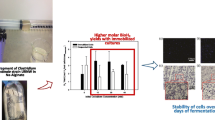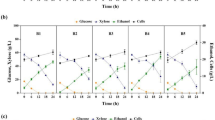Abstract
Immobilization biocatalysis is a potential technology to improve the activity and stability of biocatalysts in nonaqueous systems for efficient industrial production. Alginate-chitosan (AC) microcapsules were prepared as immobilization carriers by emulsification-internal gelation and complexation reaction, and their contribution on facilitating the growth and metabolism of yeast cells were testified successfully in culture medium-solvent biphasic systems. The cell growth in AC microcapsules is superior to that in alginate beads, and the cells in both immobilization carriers maintain much higher activity than free cells, which demonstrates AC microcapsules can confer yeast cells the ability to resist the adverse effect of solvent. Moreover, the performance of AC microcapsules in biphasic systems could be improved by adjusting the formation of outer polyelectrolyte complex (PEC) membrane to promote the cell growth and metabolic ability under the balance of resisting solvent toxicity and permitting substrate diffusion. Therefore, these findings are quite valuable for applying AC microcapsules as novel immobilization carriers to realize the biotransformation of value-added products in aqueous-solvent biphasic systems.
Similar content being viewed by others

References
Arabi H, Yazdi M T, Faramarzi M A. 2010. Influence of whole microalgal cell immobilization and organic solvent on the bioconversion of androst-4-en-3, 17-dione to testosterone by Nostoc muscorum. Journal of Molecular Catalysis B: Enzymatic, 62(3–4): 213–217.
Bezerra C S, De Farias Lemos C M G, De Sousa M, Gonçalves L R B. 2015. Enzyme immobilization onto renewable polymeric matrixes: past, present, and future trends. Journal of Applied Polymer Science, 132(26): 42 125.
Bommarius A S, Paye M F. 2013. Stabilizing biocatalysts. Chemical Society Reviews, 42(15): 6 534–6 565.
Börner RA, Aliaga MTA, Mattiasson B. 2013. Microcultivation of anaerobic bacteria single cells entrapped in alginate microbeads. Biotechnology Letters, 35(3): 397–405.
Bornscheuer U T, Huisman G W, Kazlauskas R J, Lutz S, Moore J C, Robins K. 2012. Engineering the third wave of biocatalysis. Nature, 485(7397): 185–194.
Cirino P C, Sun L H. 2008. Advancing biocatalysis through enzyme, cellular, and platform engineering. Biotechnology Progress, 24(3): 515–519.
Cui J H, Cao Q R, Choi Y J, Lee K H, Lee B J. 2006. Effect of additives on the viability of bifidobacteria loaded in alginate poly-l-lysine microparticles during the freeze-drying process. Archives of Pharmacal Research, 29(8): 707–711.
De Carvalho C C C R. 2011. Enzymatic and whole cell catalysis: Finding new strategies for old processes. Biotechnology Advances, 29(1): 75–83.
Dennewald D, Hortsch R, Weuster-Botz D. 2012. Evaluation of parallel milliliter-scale stirred-tank bioreactors for the study of biphasic whole-cell biocatalysis with ionic liquids. Journal of Biotechnology, 157(1): 253–257.
Es, I, Vieira J D G, Amaral A C. 2015. Principles, techniques, and applications of biocatalyst immobilization for industrial application. Applied Microbiology and Biotechnology, 99(5): 2 065–2 082.
Gao M, Song H Y, Zheng H Z, Ren Y, Li S, Liu X D, Yu W T, Ma X J. 2016. Culture of low density E. coli cells in alginate-chitosan microcapsules facilitates stress resistance by up-regulating luxS/AI-2 system. Carbohydrate Polymers, 141: 160–165.
Garikipati S V B J, McIver A M, Peeples T L. 2009. Whole-cell biocatalysis for 1-naphthol production in liquid-liquid biphasic systems. Applied and Environmental Microbiology, 75(20): 6 545–6 452.
Gaumann A, Laudes M, Jacob B, Pommersheim R, Laue C, Vogt W, Schrezenmeir J. 2000. Effect of media composition on long-term in vitro stability of barium alginate and polyacrylic acid multilayer microcapsules. Biomaterials, 21(18): 1 911–1 917.
Goranov B, Blaziiva D, Kostov G, Denkova Z, Germanova Y. 2013. Lactic acid fermentation with encapsulated Lactobacillus Casei ssp. Rhamnosus ATCC11979 (NBIMCC1013) in alginate-chitosan matrices. Bulg. J. Agric. Sci., 19(2): 101–104, https://doi.org/www.researchgate.net/publication/258047099_Lactic_acid_fermentation_with_encapsulated_Lactobacillus_casei_SSP_rhamnosus_ATCC_11979_NBIMCC_1013_in_alginate_chitosan_matrices.
Hou D D, Li H J, Song H Y, Dai X M, Yu W T, Liu X D, Ma X J. 2012. Size and strength of alginate-chitosan microcapsules in nonaqueous system. CIESC Journal, 63(5): 1 522–1 528. (in Chinese with English abstract)
Kansal H, Banerjee U C. 2009. Enhancing the biocatalytic potential of carbonyl reductase of Candida viswanathii using aqueous-organic solvent system. Bioresource Technology, 100(3): 1 041–1 047.
Kisukuri C M, Andrade L H. 2015. Production of chiral compounds using immobilized cells as a source of biocatalysts. Organic & Biomolecular Chemistry, 13(40): 10 086–10 107.
Liouni M, Drichoutis P, Nerantzis E T. 2008. Studies of the mechanical properties and the fermentation behavior of double layer alginate-chitosan beads, using Saccharomyces cerevisiae entrapped cell. World Journal of Microbiology and Biotechnology, 24(2): 281–288.
Marques M P C, De Carvalho C C C R, Cabral J M S, Fernandes P. 2010. Scaling-up of complex whole-cell bioconversions in conventional and non-conventional media. Biotechnology and Bioengineering, 106(4): 619–626.
Naydenova V, Badova M, Vassilev S, Iliev V, Kaneva M, Kostov G. 2014. Encapsulation of brewing yeast in alginate/chitosan matrix lab-scale optimization of lager beer fermentation. Biotechnology & Biotechnological Equipment, 28(2): 277–284.
Rathore S, Desai P M, Liew C V, Chan L W, Heng P W S. 2013. Microencapsulation of microbial cells. Journal of Food Engineering, 116(2): 369–381.
Ratnayake N D, Theisen C, Walter T, Walker K D. 2016. Whole-cell biocatalytic production of variously substituted β-aryl-and β-heteroaryl-β-amino acids. Journal of Biotechnology, 217: 12–21.
Reetz M T. 2013. Biocatalysis in organic chemistry and biotechnology: Past, present, and future. Journal of the American Chemical Society, 135(34): 12 480–12 496.
Rivero C W, De Benedetti E C, Lozano M E, Trelles J A. 2015. Bioproduction of ribavirin by green microbial biotransformation. Process Biochemistry, 50(6): 935–940.
Schrewe M, Julsing M K, Bühler B, Schmid A. 2013. Whole-cell biocatalysis for selective and productive C-O functional group introduction and modification. Chemical Society Reviews, 42(15): 6 346–6 377.
Shih I L, Chen L D, Wu J Y. 2010. Levan production using Bacillus subtilis natto cells immobilized on alginate. Carbohydrate Polymers, 82(1): 111–117.
Song H Y, Yu W T, Gao M, Liu X D, Ma X J. 2013. Microencapsulated probiotics using emulsification technique coupled with internal or external gelation process. Carbohydrate Polymers, 96(1): 181–189.
Song H Y, Yu W T, Liu X D, Ma X J. 2014. Improved probiotic viability in stress environments with post-culture of alginate-chitosan microencapsulated low density cells. Carbohydrate Polymers, 108: 10–16.
Stark D, Münch T, Sonnleitner B, Marison I W, Von Stockar U. 2002. Extractive bioconversion of 2-phenylethanol from l-phenylalanine by Saccharomyces cerevisiae. BiotechnologyProgress, 18(3): 514–523.
Wang W, Liu X D, Xie Y B, Zhang H A, Yu W T, Xiong Y, Xie W Y, Ma X J. 2006. Microencapsulation using natural polysaccharides for drug delivery and cell implantation. Journal of Materials Chemistry, 16(32): 3 252–3 267.
Wenda S, Illner S, Mell A, Kragl U. 2011. Industrial biotechnology-the future of green chemistry? Green Chemistry, 13(11): 3 007–3 047.
Wohlgemuth R. 2010. Biocatalysis-key to sustainable industrial chemistry. Current Opinion in Biotechnology, 21(6): 713–724.
Wu Z L, Yuan Y J, Hu P, Hu Z D. 1998. Studies on the two-liquid-phase culture of Japanese yew (Taxus cuspidata) for the production of paclitaxel. Chinese Traditional Herbal Drugs, 29(9): 589–592. (in Chinese with English abstract)
Yang Z Y, Ni Y, Sun Z H. 2009. Recent trend of nonaqueous enzymology and biocatalysis in nonaqueous media. Chinese Journal of Biotechnology, 25(12): 1 779–1 783. (in Chinese with English abstract)
Yu H L, Ou L, Xu J H. 2010a. New trends in non-aqueous biocatalysis. Current Organic Chemistry, 14(14): 1 424–1 432.
Yu W T, Lin J Z, Liu X D, Xie H G, Zhao W, Ma X J. 2010b. Quantitative characterization of membrane formation process of alginate-chitosan microcapsules by GPC. Journal of Membrane Science, 346(2): 296–301.
Yu W T, Song H Y, Zheng G S, Liu X D, Zhang Y, Ma X J. 2011. Study on membrane characteristics of alginatechitosan microcapsule with cell growth. Journal of Membrane Science, 377(1–2): 214–220.
Zhang F, Xue Y, Li L, Wang M. 2010. Asymmetric reduction of 3, 5-Bistrifluoromethylphenyl acetophenone by immobilized Saccharomyces rhodotorula in biphasic system. Pharmaceutical Biotechnology, 17(2): 125–129. (in Chinese with English abstract)
Acknowledgement
We thank Dr. Xin Xiong (Natural and Medical Sciences Institute at University of Tübingen, Markwiesenstr. 55, 72770 Reutlingen, Germany), and Prof. Dr. Rumen Krastev (University Reutlingen, Alteburgstr. 150, 72762 Reutlingen, Germany) for the constructive discussion and communication about biocatalysis-related issues.
Author information
Authors and Affiliations
Corresponding authors
Additional information
Supported by the National Natural Science Foundation of China (No. 21276033), the Open Foundation of the State Key Laboratory of Bioactive Seaweed Substances (Nos. SKL-BASS1707, SKL-BASS1711), and the Liaoning Provincial BaiQianWan Talents Program (No. 2017-6)
Rights and permissions
About this article
Cite this article
Hou, D., Yu, W., Zhang, D. et al. Culture of yeast cells immobilized by alginate-chitosan microcapsules in aqueous-organic solvent biphasic system. J. Ocean. Limnol. 37, 863–870 (2019). https://doi.org/10.1007/s00343-019-8126-9
Received:
Accepted:
Published:
Issue Date:
DOI: https://doi.org/10.1007/s00343-019-8126-9



